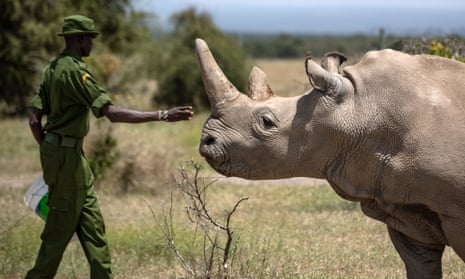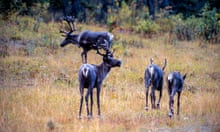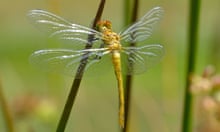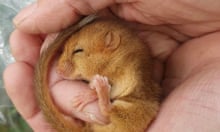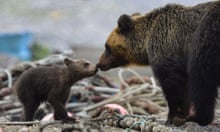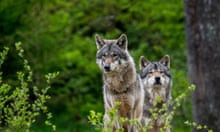Najin and her daughter Fatu, the world’s last two living northern white rhinos, inhabit an evolutionary twilight zone: the last living proof of a lineage that stretches back millions of years but is functionally extinct.
But this week, scientists came a step closer to bringing the species back from the brink of oblivion by performing the first successful embryo transfer in a related white rhino species.
The ultimate goal of restoring an entire herd of northern white rhinos using a bank of frozen eggs, sperm and embryos and gene-editing technologies may sound like a case of technological hubris – of scientists attempting to play god. But the team behind the project, and others, say that IVF and other assisted reproductive technologies (ART) could transform conservation efforts in some species and buffer against the devastating effects of climate breakdown and habitat loss.

“Scientists can offer to rewind some of these dramatic mistakes made by humans,” said Prof Thomas Hildebrandt, of the Leibniz Institute for Zoo and Wildlife Research in Berlin and head of the rhino BioRescue project. “We don’t play god. We try to preserve what god has created. We only bring back what was on this planet and was destroyed by people.”
Hildebrandt views the technology as a last-ditch insurance policy for “cornerstone” species, such as the northern white rhino, whose loss would lead to a cascade of knock-on effects for entire ecosystems. But in many species, efforts are under way long before species reach such terminal levels of decline.
“I’ve worked on giant pandas, great apes, elephants,” said Hildebrandt. Previously his team has coordinated the collection of semen from wild elephants to improve genetic diversity in zoo populations. The practical challenges can be substantial: elephants need to be immobilised using a helicopter and sperm extracted using electroejaculation. With rhinos, the collection of ovaries and embryo transfer is performed via the rectum, because the ovaries are almost 2 metres deep inside the abdomen. “We’re dealing with an animal that is 2.2 tonnes,” said Hildebrandt.
Adapting IVF protocols that were developed for commercial livestock is not always straightforward, according to Dr Andrés Gambini, of the University of Queensland, who is developing IVF techniques for the endangered Somali wild ass – a donkey species – and koalas.
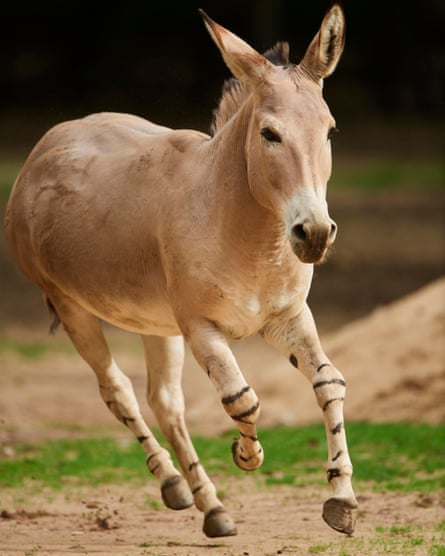
“We thought the horse is very similar to the donkey, but we did the same thing and it didn’t work,” he said. “They have a different biology.”
The work is still in progress, but he can help preserve the genes of populations alive today. “We might not transfer the embryos tomorrow or use those samples today but we know we can use them in the future,” he said. “It’s a must-do for us.”
Dr Jennifer Barfield, a veterinary scientist at Colorado State University, is using IVF to help conserve bison in the Yellowstone national park. The herd is vulnerable to a bacterial disease, brucellosis, which can cause miscarriage and infertility, but IVF can be used to produce healthy embryos that can be transferred to disease-free surrogates.
“These technologies are also used to move valuable genetics between populations in the form of sperm, eggs, or embryos which is, in many ways, easier than moving live animals,” said Barfield.
Long before species reach critical numbers, genetic diversity can become an issue. Habitat loss can result in species being fragmented into isolated pockets of territory, potentially causing genetic bottlenecks and inbreeding. ART can act as a genetic bridge between small at-risk populations.
IVF and artificial insemination are also being increasingly used in zoos, instead of transporting potential mates around the globe, when pairs of animals have failed to reproduce or when a captive introduction might pose a danger.
“A lot of animals are mate-selective, but with captive breeding, you often don’t have the ability to select a mate,” said Prof Simon Girling, head of veterinary services at the Royal Zoological Society of Scotland, who oversaw the pandas Tian Tian and Yang Guang, who failed to conceive during their decade-long stay at Edinburgh zoo.

“When you have one of each – and our two did not get on – there was no chance,” said Girling. In the absence of a romantic spark, IVF was attempted and Tian Tian had at least four chemical pregnancies, but none of them implanted, for reasons that are still not clear.
“Several eminent scientists came in and wrote reports and we enacted all the suggestions. We had bamboo shipped in from China,” said Girling, adding that some other zoos had had positive outcomes with pandas.
IVF is not going to solve species loss and, Hildebrandt points out, species are more than merely their genes. “We are really under time pressure to produce the first calves to save the social heritage,” he said. “The living animals speak the language, they know how to behave like a northern white rhino. The full package has to be respected. We want ungulates fit for the wild, not exhibits for a zoo.”
“We should change our relationship to nature dramatically,” he added. “I can see that the younger generation has a much better attitude towards this.”
